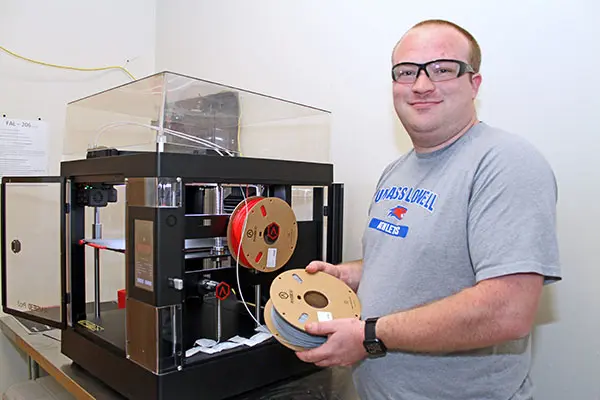From Legos to Helmets and Parachutes

09/01/2023
By Edwin L. Aguirre
As a young boy growing up in Merrimac, Massachusetts, George Barlow always enjoyed trying to figure out how things worked.
“I loved putting together and building things with Lego blocks,” he recalls.
That passion for tinkering fueled Barlow’s desire to pursue a career in mechanical engineering so he could apply his problem-solving skills and analytical thinking to helping solve real-world challenges. He went on to earn a bachelor’s degree at UMass Lowell, graduating magna cum laude in 2018.
Barlow is now completing his doctoral degree, working with Mechanical Engineering Assoc. Profs. Scott Stapleton and Murat Inalpolat in the Advanced Composite Materials and Textile Research Laboratory on projects that could help save the lives of American soldiers in the field.
As an undergraduate lab assistant, Barlow worked in the Harnessing Emerging Research Opportunities to Empower Soldiers (HEROES) lab for a year, conducting dynamic air permeability testing of parachute canopy fabrics to study the rate at which air flows through the fabrics.
“I investigated the environmental effects on the parachute fabric samples and developed MATLAB codes to process the collected data,” he says.
For his graduate research, Barlow spent three years on a HEROES project that modeled the blunt-impact performance of combat helmets used in the field.
“Blunt impact could result from a soldier falling down, banging his head on something, or a heavy object landing on his head,” he says.
For this project, he improved the existing helmet model by changing a number of features, including varying the properties and placement of the foam suspension pads inside the helmet.
Barlow ran many impact simulations using the Massachusetts Green High Performance Computing Center in Holyoke to learn more about how the changes influenced the helmet’s overall performance.
“The university offers a great engineering program... and I was able to finish my undergraduate education debt-free.” -George Barlow
“The stiffer the foam, the better its response is to blunt impact. But at the same time, it’s not going to conform to a soldier’s head comfortably. So, we made sure that the helmet model offers very good protection but is still comfortable and breathable,” he notes.
Gentex Corp., based in Zeeland, Michigan, will conduct the actual fabrication and testing of the helmet.
Barlow’s second project involves research on fiber entanglement in textile composites with the Air Force Research Laboratory.
“I’m developing a way to introduce virtual entanglement into fiber bundles in textile models used in creating composite fabrics, including woven carbon fiber textiles,” he says.
According to Barlow, in real life, the fibers have “a little bit of wandering in them.”
“Fibers can’t be perfectly straight. There will be some waviness in them, and this waviness introduces resistance to compaction,” he says.
He says that creating a method for introducing fiber entanglement into textile models would allow researchers to replicate the textile’s actual response to compaction and predict its actual performance even before they mold and fuse the carbon fiber sheets into final products.
“I enjoy seeing the results of hard work, even if it entails long hours in the lab,” he says.
For Barlow, coming to UMass Lowell was well worth it.
“The university offers a great engineering program,” he says, “and I was able to finish my undergraduate education debt-free. I could have gone to other schools, but I would have incurred a mountain of student loans.
“Thanks to UML, my education and research experiences have given me the skills that I need to succeed in my professional career.”
After he graduates in spring 2024, Barlow plans to enter industry, preferring to find a research position in a company that is close to the ocean somewhere.
“I like boating, and I have a 10-foot rigid inflatable that I try to take out on a lake a couple of times a year,” he says. “I want to own a larger boat when it becomes viable.”